This easy, creamy and delicious coconut cream pudding is coconut cream pie without the pie part. A great coconut dessert to enjoy anytime.
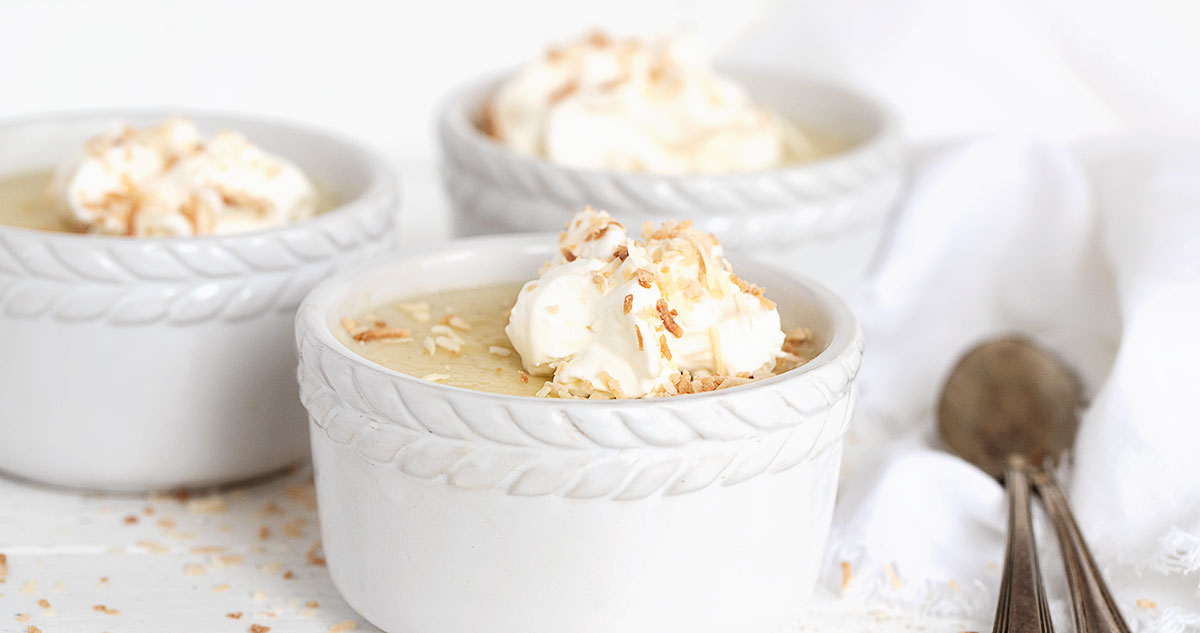
If you’re a fan of coconut cream pie, you will love this coconut cream pudding. It’s the pie without the pie part. Creamy, full of coconut flavour and a great dessert to enjoy any time.
Enjoy these puddings as individual servings, as I have done here, or just pour it into a bowl and spoon it out from there. Serve with a dollop of whipped cream and some toasted coconut.
Ingredients and substitutions
A few notes about the key ingredients …
Coconut Milk – full-fat coconut milk is recommended, for best results. I haven’t tested this recipe with light or reduced-fat coconut milk. It may work, though I suspect it will produce a thinner pudding.
Whole Milk or Half and Half Cream – I enjoy this pudding with full-fat whole milk (3.5% b.f.), though you can also use Half and Half Cream (10% b.f.), for a richer pudding, if you like. 2% milk may work, though I haven’t tested it.
You may be able to use non-dairy milk here, though I haven’t tested it myself. You may also be able to use all coconut milk, though again, I haven’t tested it. (If you do, let me know how it works).
Coconut – Any coconut is fine here (shredded, flaked, desiccated). Use what you have or what texture you prefer in the pudding. Sweetened coconut is recommended for best results.
Eggs – As this is a custard pudding, the eggs are needed for the pudding to set, so can’t be omitted.
You will also need – white sugar, cornstarch, salt, and vanilla.
How to make coconut cream pudding
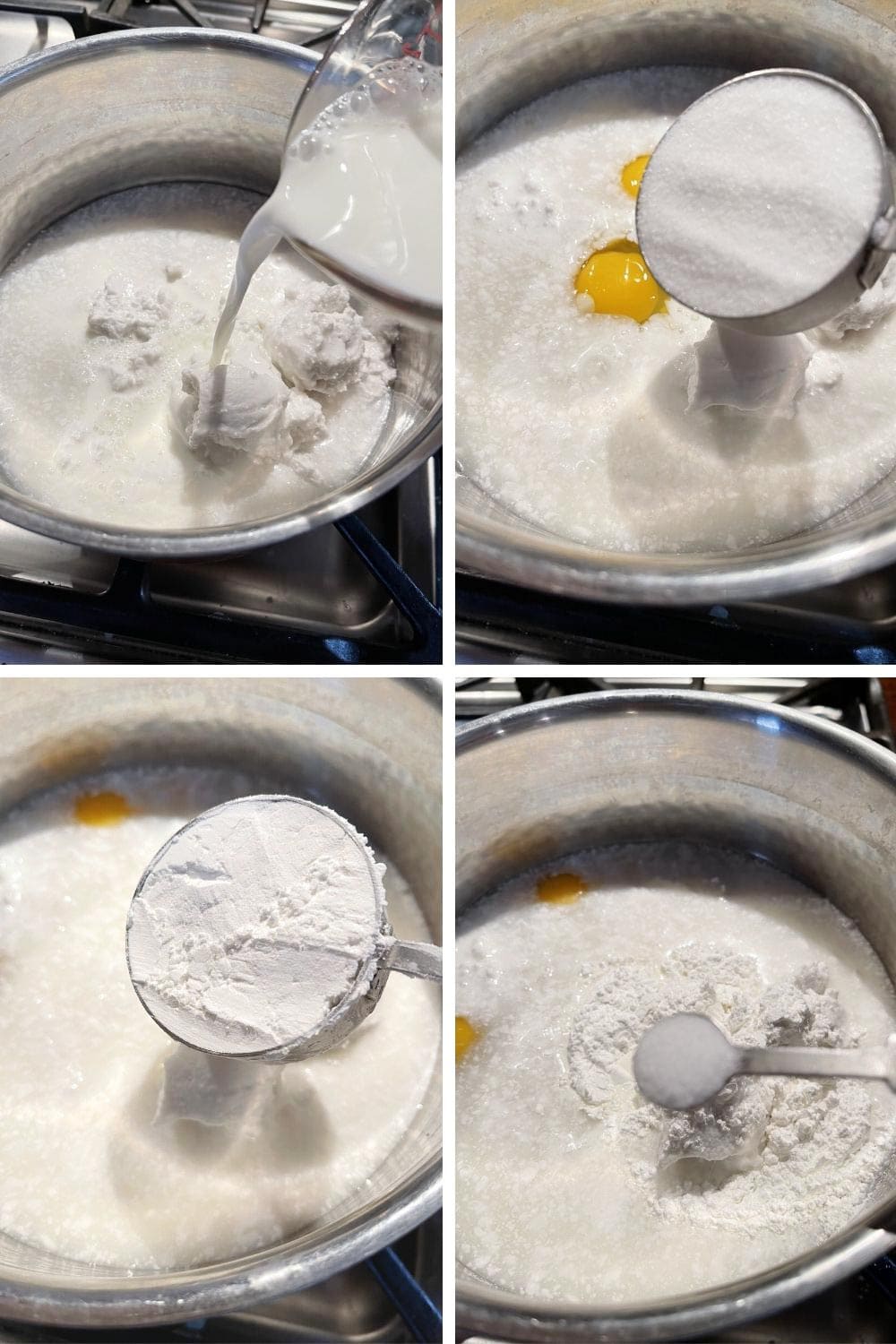
1. Start by combining all the ingredients except the coconut and the vanilla in a large saucepan. The process involves heating the mixture slowly over medium-low heat. This will take 10-15 minutes. Be patient. We need to warm the eggs slowly, so they don’t suddenly cook and you have a pot of scrambled eggs. Watch and stir regularly to start. As the mixture warms, stir constantly, so you can judge when it is done and quickly get it off the heat.
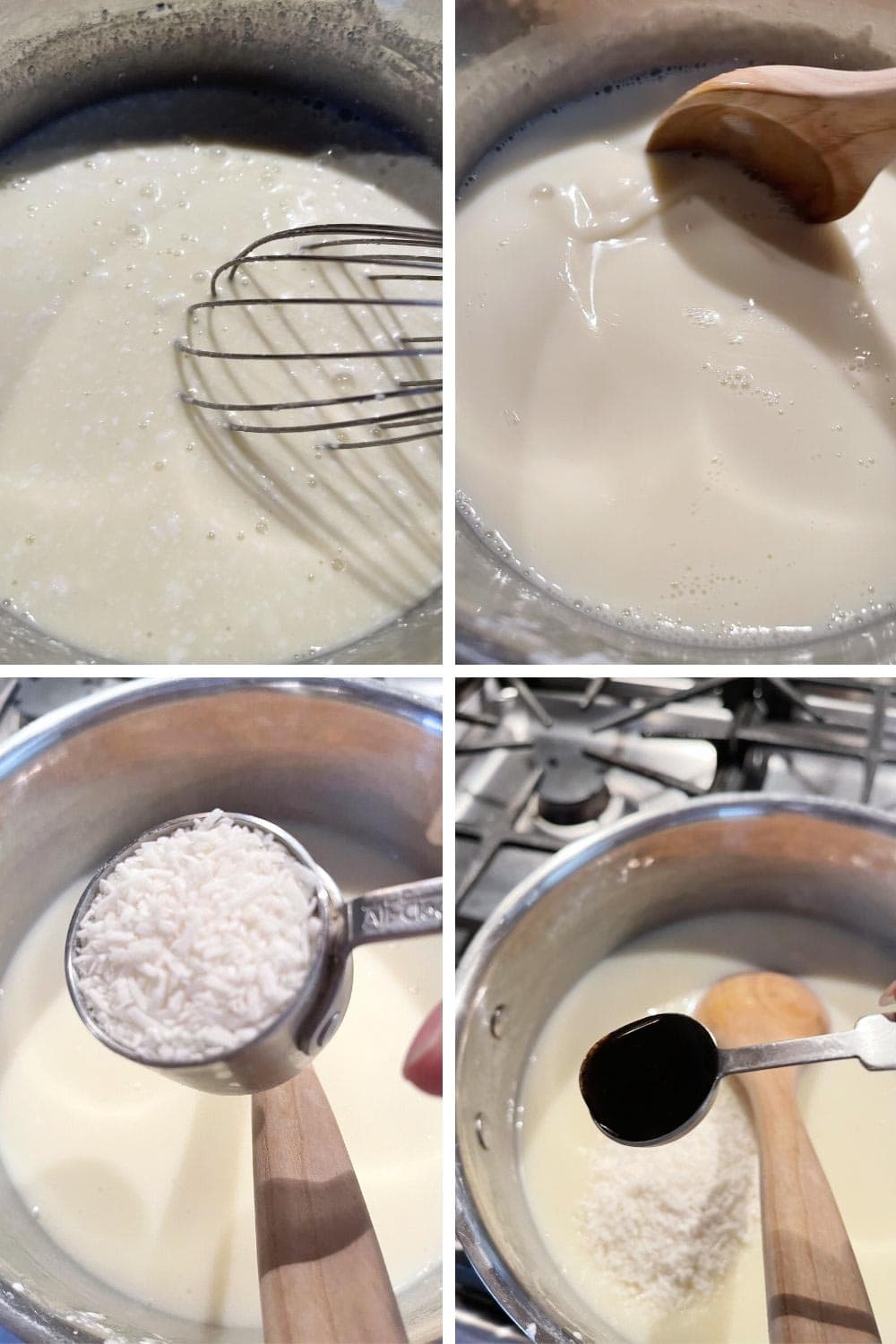
2. I start with a whisk, to make sure the mixture is nice and smooth to start. As it cooks, switch to a spoon, as it is easier to judge when the mixture is starting to thicken and nearing boiling. Once the pudding is getting close to done, I switch back to the whisk, to keep the pudding smooth. (If lumps appear, it isn’t a failure. You can generally whisk them out or pour them through a sieve before adding the coconut). When the pudding is done, remove the pot from the heat and stir in the coconut and vanilla. From there, you can ladle into individual serving dishes or into one large bowl.
Refrigerate the pudding for at least 2 hours, but it will be even better after 3 or 4 hours of refrigeration. If you like a skin on your pudding (my husband does, for sure!), leave the pudding uncovered in the fridge. If you don’t want a skin, let the plastic wrap come into contact with the top of the pudding as it refrigerates.
Recipe tips!
- You can use either whole milk or half and half cream for this pudding, or you can split the difference and use half of each. I find the pudding made with whole milk quite satisfying for basic, everyday family eating. Adding some or all half and half produces a richer and slightly thicker pudding, which is nice for a special dessert.
- As this is an egg-based pudding, you need to heat the mixture slowly, so keep the stove at the medium-low setting and be patient. You don’t want to cook the mixture to a full boil, but just to the point where one bubble will break the surface or when the mixture noticeably thickens. Sometimes, the mixture will curdle, meaning you’ll notice lumps in it. Generally, a vigorous whisk will smooth in out or an immersion blender at the end of cooking, but before adding the coconut. You can also pour it through a fine sieve into a bowl before adding the coconut, as well.
- You will get about 4 large ramekins or 6 smaller ramekins if making individual portions.
- Some may be wondering about adding coconut extract to this pudding. I don’t love extracts in general, as I never find the taste particularly pleasing and I don’t like the aftertaste. I just tend to prefer the natural flavour, even if it isn’t quite as forward as when using an extract. But that’s just me. If you want to add a half teaspoon or so, go right ahead.
- The pudding will keep in the fridge for several days, though after a certain point (48 hours-ish), it will start to thin actually, as the liquid separates from the solids. It’s still fine to eat. You can stir it back together and enjoy.
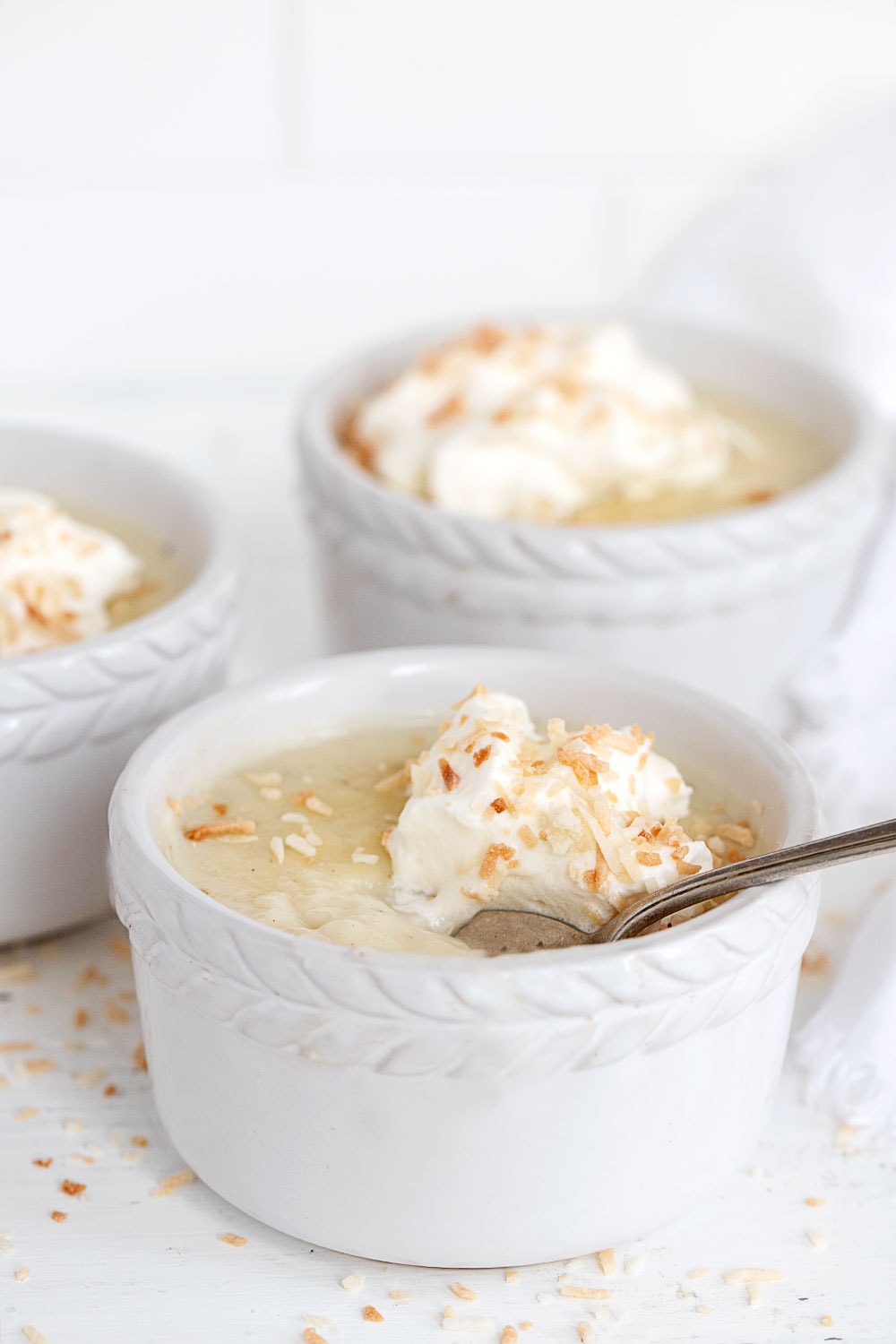
Making ahead, storing and freezing
Making ahead is built into this recipe, as it does require at least 2 hours of chilling time and is even better if it can chill 3-4 hours. The pudding will keep well in the refrigerator for 2-3 days. These puddings should freeze, though I’m not sure I’ve ever frozen them, as they never last long here.
Want to save this recipe?
Enter your email and I’ll send it to your inbox. Plus, you’ll get great new recipes from me every week!
By submitting this form, you consent to receive emails from Seasons and Suppers.
You can unsubscribe at any time.
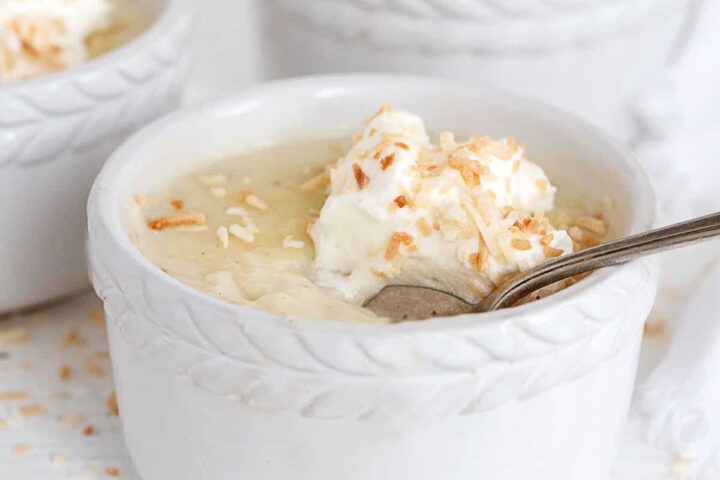
Get the Recipe: Coconut Cream Pudding
Ingredients
- 14 oz (400 ml) full-fat coconut milk, not light or fat-reduced
- 1 1/4 cups whole milk (3.5%) or half and half cream (10%), or half of each
- 2 large eggs
- 3/4 cups white sugar
- 1/3 cup cornstarch
- 1/4 teaspoon salt
- 1/4 cup sweetened shredded coconut
- 1 teaspoon vanilla extract, or vanilla bean paste
For topping to serve (optional):
- Whipped Cream
- Toasted Coconut *see Notes
Instructions
- Combine the coconut milk, milk or half and half, eggs, sugar, cornstarch and salt in a large saucepan. Whisk until smooth. Place over medium-low heat and cook, stirring regularly to start, then constantly once it starts to steam. This will take about 10-15 minutes, so be patient.
- Once mixture noticeably thickens and a bubble breaks the surface (at about 205F, if you have a thermometer), it’s done. Remove from heat. Whisk well to remove any lumps or if still a little lumpy, you can pour and press through a fine sieve into a bowl or use an immersion blender before adding the coconut and vanilla. Remove from the heat and add the 1/4 cup processed coconut and the vanilla. Pour into individual ramekins or one large bowl.
- If you don't want a skin on your pudding, cover with plastic wrap so the plastic wrap rests right on top of the pudding. Leave uncovered in the refrigerator if you want a skin. Refrigerate at least 2 hours, but better after 3-4 hours of refrigeration. The pudding will thicken further as it refrigerates.
- Serve with a dollop of whipped cream and a sprinkling of toasted coconut.
Notes
- You can use either whole milk or half and half cream for this pudding, or you can split the difference and use half of each. I find the pudding made with whole milk quite satisfying for basic, everyday family eating. Adding some or all half and half produces a richer and slightly thicker pudding, which is nice for a special dessert.
- As this is an egg-based pudding, you need to heat the mixture slowly, so keep the stove at the medium-low setting and be patient. You don’t want to cook the mixture to a full boil, but just to the point where one bubble will break the surface or when the mixture noticeably thickens. Sometimes, the mixture will curdle, meaning you’ll notice lumps in it. Generally, a vigorous whisk will smooth in out or an immersion blender at the end of cooking, but before adding the coconut. You can also pour it through a fine sieve into a bowl before adding the coconut, as well.
- You will get about 4 large ramekins or 6 smaller ramekins if making individual portions.
- Some may be wondering about adding coconut extract to this pudding. I don’t love extracts in general, as I never find the taste particularly pleasing and I don’t like the aftertaste. I just tend to prefer the natural flavour, even if it isn’t quite as forward as when using an extract. But that’s just me. If you want to add a half teaspoon or so, go right ahead.
- The pudding will keep in the fridge for several days, though after a certain point (48-hours-ish), it will start to thin as the liquid separates from the solids. It’s still fine to eat. You can stir it back together and enjoy.
More coconut recipes to love!
Hi! I’m Jennifer, a home cook schooled by trial and error and almost 40 years of getting dinner on the table! I love to share my favourite recipes, both old and new, together with lots of tips and tricks to hopefully help make your home cooking enjoyable, stress free, rewarding and of course, delicious!




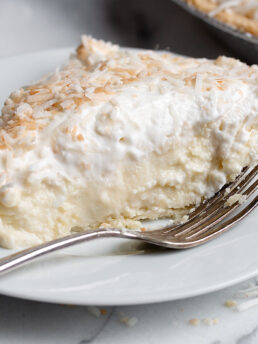
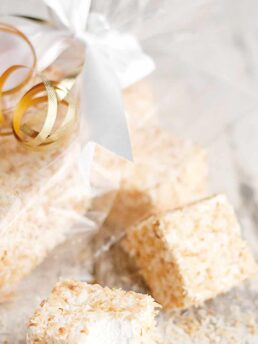

Best pudding recipe ever! I made it for one person, followed the directions exactly and it turned out beautifully.
So glad to hear, Jill :) Thanks so much!
Do you recommend any non-corn thickener to replace corn starch?
We live in Panama and have a small business making cold-pressed coconut oil. There is always fresh grated coco available, and fresh, full fat coconut cream, but no recipes. There are a few local uses but for the most part cocos are overlooked, and in the world where there are recipes, all the products are canned, frozen, or dried:) Once i decide on a thickener, i’ll try your recipe with fresh coco cream, which is incredibly rich. it might be a mercy to dilute it a bit with coco water…. We’ll see how it goes:) Thanks for your inspiration!
Hi Eugenie, arrowroot powder is a common substitute for corn starch. Enjoy!
Super easy and very yummy. . Sure to be a family favourite. Mine did curdle as I cooked it but a good whisk as recommended and it was fine . Served with tropical fruits and mango sauce it was a hit. Thank you.
So glad you enjoyed it! Thanks so much :)
If I were to spoon this into a cooked pie shell do you think it would set enough to be sliced, or would I have to change/add something to the recipe?
Hi Lisa, I’m not sure if this pudding would be thick enough to slice. You might want to try my coconut cream pie recipe instead.
Just made this, triple recipe, to pair with a Thai Green Curry dish I will be serving at our long weekend camping getaway with friends. I put a little to much cayenne in the curry so had to borrow a can of the coconut cream I was going to use for the pudding. I used heavy cream (also wasn’t thinking when I was at the store) and added extra in place of the missing coconut – and right around the 180F mark I was thinking it wasn’t going to work – it was thickening but also clumping (I whisked the entire time). I followed your advice and immersion blended it – and also strained it. It is magical and I think it will be a hit with all of our pals.
So glad to hear! Enjoy :)
Did 1/8 tsp stevia for 1/4 cup sugar. Tastes amazing still.
Btw… Equal opportunity eater??? Gna borrow that!
Also did coconut cream. I had used some coco cream already so added a little milk to supplement. Tastes so good and I am a harsh critic!
So glad you enjoyed it, Joanna :) Thanks so much!
I made this today & they’re in the fridge now… Used ramekins on some of the mixture after filling the pie dish… I’m sure my guests tomorrow will love this… Can I put caramel (like brulee) for those in ramekins?.. Thank you Jennifer for this lovely treat. ❤
Hi Josie, I usually just top the ramekins with toasted coconut, but if you have another idea, I say go for it :) Enjoy!
Absolutely dreamy good made with coconut cream! So good,creamy, without the shredded coconut I had a bowl warm! Thank You!
So glad to hear, Sonja :) Thanks so much!
This was amazing! We made it with coconut cream instead of half and half and it was delicious. Will definitely be making this again.
So glad you enjoyed it, Hannah! Thanks so much :)
Can this be made with coconut cream? They look delicious!
Hi Linda and possibly. I haven’t tried it, but, in theory, it should work, though it would be much more rich, I suspect. If you try it, let me know how it works out!
Such a lovely treat, I love these mini coconut puddings. Delicous!
Thanks Milena :)
Coconut cream pie has always been one of my favorite desserts Jennifer, so I know I’d love these little puddings! They look delicious!
Thanks Mary Ann and it’s always been a favourite of mine, too :)
I have such fond memories of coconut cream pie from when I was a kid so I know I’d love this pudding! Just what my Monday needs :)
Thanks Dawn and yes, a great Monday treat :)
I need this now! Wait …..asking my wife a question.,Christine can you make this for me? You know I love coconut. Jenifer she said she will make it for me.. thanks this looks like a keeper for me all the flavours are for me.
Lol! So glad, Pat. This is one of my favourites. Enjoy :)